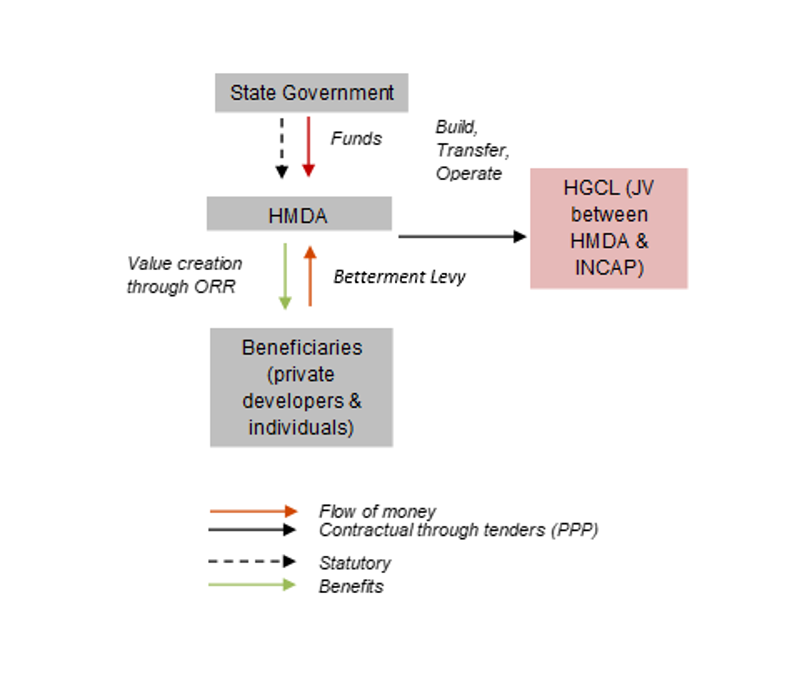Betterment Levy for Hyderabad Outer Ring Road, India

Photo Credit: Image by 4045 on Freepik
On this page: Lessons Learned on Government investment in integrated public infrastructure in zones and the implementation of Betterment Levy. Find case studies below, or visit the Guidelines on Innovative Revenues for Infrastructure section.
Project Summary: Background Government investment in integrated public infrastructure in zones can lead to 'betterment' of that zone, increasing its productivity, attractiveness and value for communities using those places and spaces. Betterment Levy imposes fees on land that has gained value because of improvements in public infrastructure invested by the government. A few cities in India have already used Betterment Levy as an LVC tool. In Hyderabad, Hyderabad Metropolitan Development Authority (HMDA) uses area-based land value capture (LVC) mechanisms such as impact fees and betterment charges to generate revenues. Project Structure The Hyderabad Outer Ring Road (ORR) is a 158-km, eight-lane ring road expressway encircling Hyderabad and connects to more than 30 radial roads, allowing cars to bypass the crowded city center and to move around the city more efficiently, lessening traffic, noise, and pollution in the urban center.1 Areas around the corridor (Growth Corridor) is classified as a mixed land use zone integrating land use and transport planning through planned satellite townships and a metro system. Because of the ORR construction, the Hyderabad Metropolitan Development Authority (HMDA) had anticipated large-scale development and other problems that emerge from high-density commercial development, such as traffic congestion.2 The corridor aims to develop well-planned and well-connected urban settlements and satellite townships around the Hyderabad Metropolitan area. HMDA prepared a Comprehensive Plan and Special Development Regulations for the areas falling within the Growth Corridor.3 Key players for delivering improved services This Betterment Levy mechanism is a collaboration among multiple stakeholders, which are Hyderabad State Government, banks, HUDA, local authorities, and beneficiaries of the ORR (private developers and individuals) HGCL (Hyderabad Growth Corridor Limited) is an SPV that was set up to execute the construction of the ORR that was procured through PPP. The project's total cost was evaluated to be Rs. 6,696 crores (around 8.4 billion USD), of which Rs. 699 crores (around 87 million USD) amounting to the first phase was provided through loans borrowed from a consortium of commercial banks led by the Bank of Baroda. Rs. 2,439 crores (around 3 billion USD) were financed through PPP and supported the first part of the project's second phase.4 Mechanism/s for Maximizing Funding for Infrastructure The Hyderabad Local Government raised revenue for funding repayment of the upfront capital investment from real-estate development around the ORR using area-based charges as follows: Both mechanisms are one-time charges collected to pay for public infrastructure requirements that emerge from new developments. Revenues from SDCs and DDCs from 2011 to 2015 were lumped under HDMA’s development charges revenues. In 2016, SDC receipts were 3-4 percent of total development charges and contributed 1.5 percent to net revenues of HDMA. Revenues from SDC are directed to general budget and reporting lack sufficient granular data on outflows of revenues captured and allocations are not traceable. Typical Business Model Lesson Learned Managing the risks Footnote 1: Urban land value capture in São Paulo, Addis Ababa, and Hyderabad: differing interpretations, equity impacts, and enabling conditions Footnote 4: Value Capture Finance Policy Framework

Telangana State Government
Source of funds
HMDA (Hyderabad Metropolitan Development Authority)
Planning agency - Receives funding to provide core services (i.e., toll roads) and collect charges from beneficiaries
HGCL
Joint venture – between HMDA & INCAP, responsible for a construction
Beneficiaries
Pays set charges based on zones because of infrastructure improvements
The Guidelines on Innovative Revenues for Infrastructure (IRI) is intended to be a living document and will be reviewed at regular intervals. They have not been prepared with any specific transaction in mind and are meant to serve only as general guidance. It is therefore critical that the Guidelines be reviewed and adapted for specific transactions.
To find more, visit the Innovative Revenues for Infrastructure section and the Content Outline, or Download the Full Report. For feedback on the content of this section of the website or suggestions for links or materials that could be included, please contact the Public-Private Partnership Resource Center at ppp@worldbank.org.
Updated:
TABLE OF CONTENTS
I. Innovative Revenues for Infrastructure (IRI)
2. Introduction to Commercial Value Capture (CVC)
3. Applying CVC in Infrastructure Projects
2. Case Studies in CVC from International Experiences
3.100 Case Studies: Municipal PPP Framework
Related Content
Select WBG PPP Toolkits
Featured Section Links
Additional Resources
Climate-Smart PPPs
Type of ResourceFinance Structures for PPP
Type of ResourceFinancing and Risk Mitigation
Type of Resource